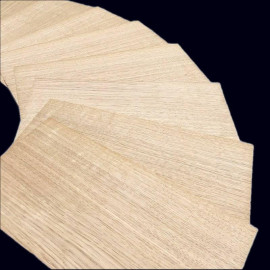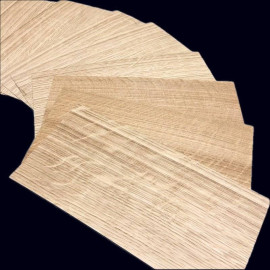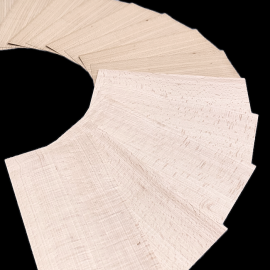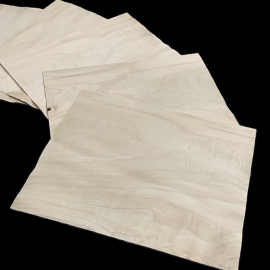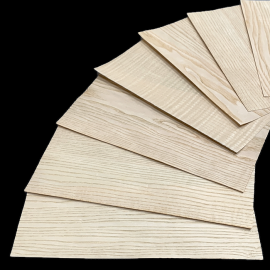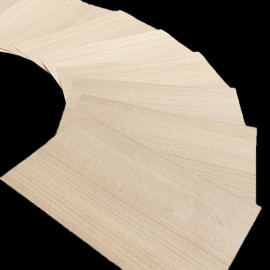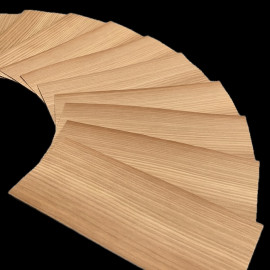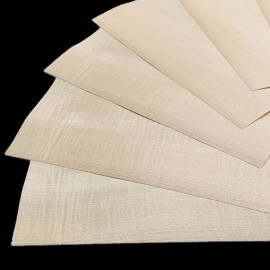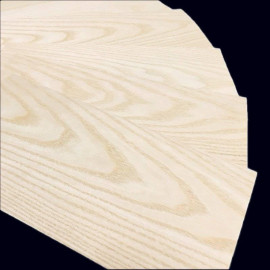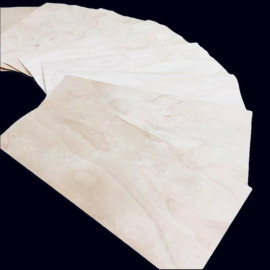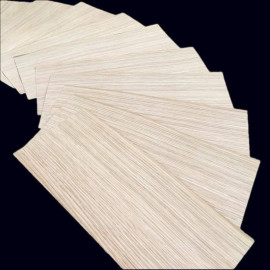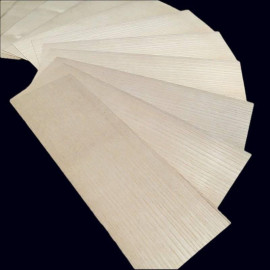Filter By
Species
Species
-
(no filter) Afrormosia Aniegre Ash Basralocus Beech Birch Black Limba Bubinga Cedar Cerejeira Chen-chen Cherry Chestnut Ebony Elm Eucalyptus Iroko Larch Lati Leopardwood Mahogany Makore Mansonia Maple Movingui Oak Okoume Olive Palmtree Pau Rosa Pearmaple Pearwood Poplar Purpleheart Rosewood Sapelli Satin Walnut Servicetree Spruce Sycamore Tamo Teak Tiama Walnut Wenge
Width group
Width group
Thickness group
Thickness group
Grade
Grade
Brand
Brand
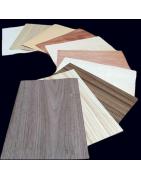
Small sizes veneer
Small-size genuine wood veneers.
These are genuine wood veneers with a fixed length of 30 cm.
Widths are the one nature given us:
From 8 to 13 cm for the narrow ones.
From 14 to 21 for standard widths.
Tag XXL for 22 cm and broader veneers.
Thicknesses are from 0.3 mm to 3 mm.
Please use the filters on the left side of your screen to find your small-size veneers upon more than one hundred references.
Active filters
Flaky Oak narrow-width small-size veneer
Flaky Oak narrow-width small-size veneer
Genuine wood sliced-veneer sheets.
Fix length of 30 cm long.
Width: From 10 to 14 cm.
Thickness: 0.6 mm.
Sold by the sheet.
Natural Beech Narrow-width Small-size Veneers
Natural Beech Narrow-width Small-size Veneers
Genuine wood sliced-veneer sheets.
Selected single veneers, no sequence.
Fix length of 30 cm long.
Width: From 10 to 14 cm, depending on availability.
Thickness: 0.6 mm.
Sold by the sheet.
Poplar Small-size Veneers
Poplar Small-size Veneers
Genuine wood sliced-veneer sheets.
Selected single veneers, no sequence.
Fix length of 30 cm long.
Width: From 15 to 21 cm, depending on availability.
Thickness: 0.68 mm.
Sold by the sheet.
0.3 mm White Ash Narrow-width Small-size Veneers
0.3 mm White Ash Narrow-width Small-size Veneers
Genuine wood sliced-veneer sheets.
Selected single veneers, no sequence.
Fix length of 30 cm long.
Width: From 10 to 14 cm.
Thickness: 0.3 mm.
Sold by the sheet.
Warning: Please read the complete description carefully.
Natural Beech 0.3 mm Small-size Veneers
Natural Beech 0.3 mm Small-size Veneers
Genuine wood sliced-veneer sheets.
Fix length of 30 cm long.
Width: From 15 to 21 cm.
Thickness: 0.3 mm.
Sold by the sheet.
Warning, the thickness is particularly thin.
Larch Small-size Narrow Veneers
Larch Small-size Narrow Veneers
Genuine wood sliced-veneer sheets.
Fix length of 30 cm long.
Width: From 10 to 14 cm.
Thickness: 0.7 mm.
Sold by the sheet.
Shadow Figure Sycamore 0.3 mm small-size veneer
Shadow Figure Sycamore 0.3 mm small-size veneer
Genuine wood sliced-veneer sheets.
Fix length of 30 cm long.
Width: From 15 to 21 cm.
Thickness: 0.3 mm.
Sold by the sheet.
Warning: Please read carefully the description hereunder.
White Ash crown-cut narrow-width small-size veneer
White Ash crown-cut narrow-width small-size veneer
Genuine wood sliced-veneer sheets.
Selected singles veneers, not in sequence.
Fix length of 30 cm long.
Width: From 10 to 14 cm.
Thickness: 0.6 mm.
Sold by the sheet.
Birch narrow-width small-size veneer
Birch narrow-width, small-size veneer
Genuine wood sliced-veneer sheets.
Single-selected veneers, no sequence.
Fix length of 30 cm long.
Width: From 10 to 14 cm.
Thickness: 0.6 mm.
Sold by the sheet.
American white Oak narrow width small-size veneer
American white Oak narrow width small-size veneer
Genuine wood veneer sheets.
Fix length of 30 cm long.
Width: From 10 to 14 cm.
Thickness: 0.6 mm.
Sold by the sheet.
White Ash narrow-width small-size veneer
White Ash Narrow-width Small-size veneers
Genuine wood sliced-veneer sheets.
Single-selected veneers, not in sequence.
Fix length of 30 cm long.
Width: From 9 to 14 cm.
Thickness: 0.6 mm.
Sold by the sheet.
 English
English


